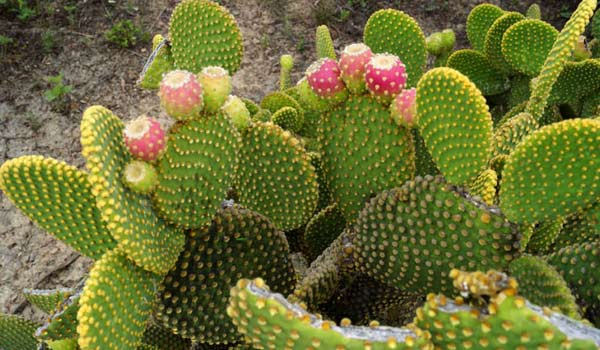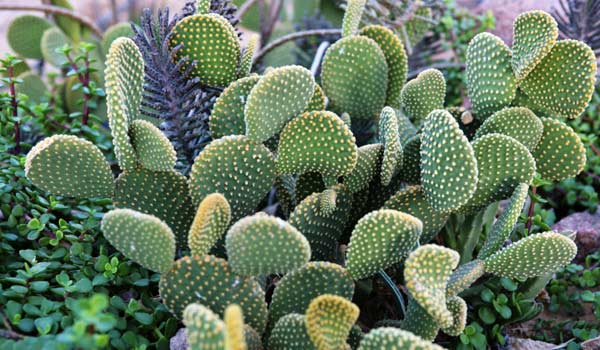Bunny Ear Cactus Care & Grow Guide

Just as its name suggests, the bunny ear cactus is, without doubt, one of the most adorable cacti to grow indoors and outdoors. Scientifically named Opuntia microdasys, you may know this plant by the name of angel’s wings, bunny cactus, or polka-dot cactus.
As a flowering species from the Cactaceae family, this plant originally comes from dry areas of central and northern Mexico. If you are wondering about adding this charming plant to your succulent collection, you have come to the right place.
In the following, we will know more about bunny ear cactus types, their care, and growing tips as well as their common problems.
More about Bunny Ear Cactus
You can identify an angel’s wings cactus by its segmented pads, resembling bunny ears (more than angle’s wings and hence the name). These pads are red in color when they are young, and take on a dark green as they mature. By that time, they are covered in white to yellow bristly hairs also known as glochids.
These dense clusters of spines are 2 to 3 mm long, barbed and thin. They also detach in large numbers when you slightly touch them. In case this happened, make sure to remove bunny ear cactus pricks as soon as possible with tweezers. As they cause considerable skin irritation.
A mature Opuntia microdasys can grow up to 16 to 24 in height; and if you think of the prickly pear cactus when you look at this plant, it is because that the bunny cactus is actually its cousin. This plant also produces beautiful creamy yellow blooms from the terminal ends of its pads. However, bunny ear cactus flowers appear veryrarely that later turn into fruits.
Bunny ear cactus fruits have an egg-like shape and are referred to as nopales, cactus pear, or simply prickly pear. The fruits grow up to 2 inches, varying from red to purple in color. They are not poisonous, but some of them do not taste good at all. In fact, even bunny ear cactus types’ leaves are also non-poisonous.

Bunny Ear Cactus Types
In addition to the prickly pear cactus, there are other Opuntia species in the same family similar to the polka-dot cactus in terms of looks and care. For example:
- Eastern prickly pear
- Desert prickly pear
- Violet prickly pear
- Texas prickly pear
- Plains prickly pear
- Blind Prickly pear
- Beavertail cactus
- Opunita macrocentra
- Opunita lindheimeri
- Opunita chlorotica
- Opuntia stricta
- Etc.
Bunny Ear Cactus Care
Thanks to its ease of care, growing bunny ears cactus is a delight for both novice and professional gardeners. The most important requirements in bunny ear cactus care are as follows:
- Light: Always place this plant in direct sunlight, so it can receive at least 14 hours of light each day. The right bunny ear cactus sunlight is crucial for its growth. So, if such a spot is not available, use white fluorescent lights as an alternative. In the winter, place your angel’s wings in a spot with partial sunlight.
- Temperature: When growing outdoors, remember that this plant prefers temperatures above 50 degrees Fahrenheit and does not tolerate frost.
- Soil: Grow your plant in a well-draining sandy potting mix, so it can retain moisture while draining any excess water. If you prefer not to buy commercial mixes, simply combine some potting mix with perlite and peat moss.
- Water: Similar to bunny ear cactus sunlight, proper watering is also vital for having a healthy plant. Each time that the top inch of the potting mix is dry, thoroughly soak it and do not water again until the soil has completely dried out. Also, do not water in the winter months.
- Feeding: This cute plant can grow in poor soil mixes with no problem. But it would appreciate it if you feed it with a cactus fertilizer in the early spring to encourage growth during its active period.
- Potting: In bunny ear cactus care, it is recommended to pot it in an unglazed and porous clay pot with drainage holes. Therefore, excess water will drain easily and the risk of root rot and mealybugs is reduced to a minimum.
- Repotting: It is a good idea to repot your Opuntia microdasys every year or two (when the roots outgrow the pot) to encourage its growth. Remember to always repot your cacti before its growing season in warmer months. Also, do not forget to wear gloves when handling the plant.
These are the main bunny ear cactus care tips that you are going to need. In the next part, we will talk about bunny ear cactus problems so you can enjoy having a pest and disease-free plant.

Bunny Ear Cactus Problems
Similar to many other cacti, the polka-dot cactus is also sensitive to overwatering as it can lead to stem base rot. So avoid watering too much during the winter. If stem base rot happens, the plant is likely to die (unless some miracle happens). In this case, we suggest taking bunny ear cactus cuttings for propagation.
Pad tips shriveling is another sign of overwatering too. If your plant is not growing, lack of or too much watering can be the reason. Adjust the watering to solve the issue.
Insects are also among bunny ear cactus problems. Mealy bugs cause white patches on the pads, while scale insects cause a brown scab effect on them. However, a drop in temperature and cause brown patches as well. Wipe the insects using a cotton ball soaked in alcohol.
Bunny Ear Cactus Propagation
To have a successful propagation, you need to start in the summer, so your young plant has enough time to root before the winter arrives and the weather gets too cold.
Start by removing a mature pad from the mother plant. You can remove several bunny ear cactus cutting as well. Make sure to wear a glove or use tweezers to avoid the spines.
After removing, set the cutting aside and let them dry out and callus for several days. Now plant the dried cutting beneath an inch of cactus soil mix in an unglazed clay pot. Place the pot in a sunny spot and wait for a week or two so the root system develops.
Water your young polka-dot cactus regularly during the first year to encourage the growth of its root system.
Happy cultivating!
- In this post:
- More about Bunny Ear Cactus
- Bunny Ear Cactus Types
- Bunny Ear Cactus Care
- Bunny Ear Cactus Problems
- Bunny Ear Cactus Propagation



